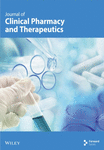Serum protein binding kinetics of phenytoin in monotherapy patients
Abstract
Objectives: To determine the binding characteristics of phenytoin to serum proteins in the Japanese population and to compare these with those reported by other investigators. Method: Serum samples examined in the study were obtained from 72 patients (35 males, 37 females) receiving phenytoin monotherapy. The patients’ ages ranged from 1 to 73 years (1–15 years, 36 subjects; 16–44 years, 20 subjects; 45–64 years, 13 subjects; ≥65 years, 3 subjects). Results: The in vivo population binding parameters of phenytoin to serum proteins and theoretical minimal unbound serum phenytoin fraction ( fu) were determined using the Scatchard equation. The association constant ( K) was 0·020 l/μmol, while the total concentration of binding sites ( n(Pt) was 556 μmol/l. The number of binding sites per albumin molecule ( n) was 0·85, while binding ability (n · K) was 0·017 l/μmol. The fu was 0·083. The n · K is approximately 1·1 times higher in patients of Pospíšil et al. ( 26) (i.e. 0·0191 l/μmol) than in all our patients. The association contant is approximately 1·1 times higher in our study than in the in vitro study of Monks et al. ( 23) (i.e. 0·0186 l/μmol), while n is similar between the two studies. The fu in our patients is similar to the unbound serum phenytoin fraction in adult patients receiving phenytoin therapy reported by Richens ( 2) (i.e. 0·1). Conclusion: Our results suggest that there may be small differences in the binding characteristics of phenytoin to serum proteins between Japanese and non-Japanese subjects. The unbound serum fraction of phenytoin in our patients with epilepsy can be assumed to be relatively constant in the therapeutic concentration range of phenytoin.




